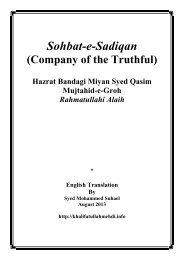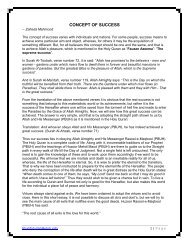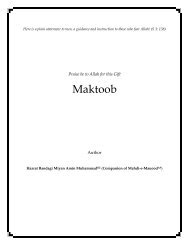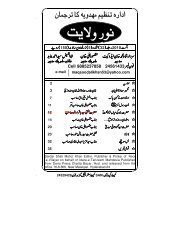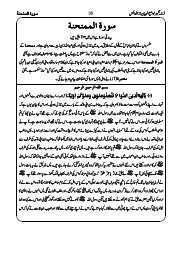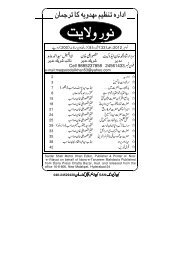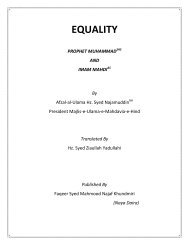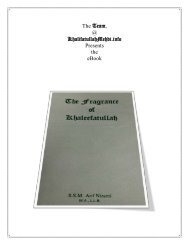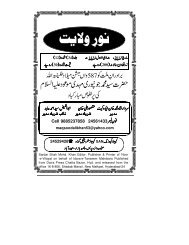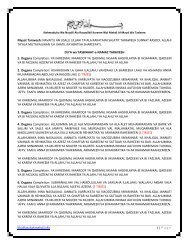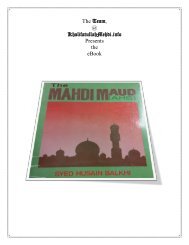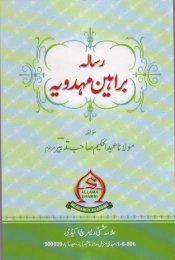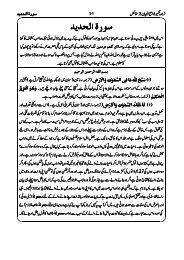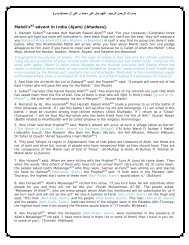Naqliyat-e-Miyan Abdur Rasheed RZ - Khalifatullah Mehdi (AHS)
Naqliyat-e-Miyan Abdur Rasheed RZ - Khalifatullah Mehdi (AHS)
Naqliyat-e-Miyan Abdur Rasheed RZ - Khalifatullah Mehdi (AHS)
Create successful ePaper yourself
Turn your PDF publications into a flip-book with our unique Google optimized e-Paper software.
27<br />
was working at Nanded. I informed him about the missing book and<br />
requested him to keep in touch with the railway authorities. I went<br />
to Kalmanuri. My brother had recovered. I returned to Nanded the<br />
next day. When I came to the railway station, the stationmaster gave<br />
me the glad tidings. The book had come. I paid the necessary<br />
amount of money to cover the expenses. When the book came into<br />
my hands, I saw that it was decently packed with the seal of the<br />
Aurangabad railway Police.<br />
The readers know that Aurangabad is eight hours train journey<br />
away from Nanded. There are many big and small railway stations<br />
on the way. Numerous people entrain and detrain at these stations.<br />
Despite all this, the return of a book that was lying uncared for on a<br />
seat is no ordinary event. Certainly, Allah Who answers the prayers<br />
had answered the supplications of this faqir by the intervention of<br />
the soul of Bandagi <strong>Miyan</strong> Shah Yaqub Hasan-e-Vilayat <strong>RZ</strong> .<br />
QUALITY OF THE BOOK<br />
Comparing the five copies of the manuscript of Naqliat has<br />
shown that the book has passed through three stages of<br />
development. The two copies of Janab Faqir Amir <strong>Miyan</strong> Sahib of<br />
Akeli and Janab Faqir Syed Dilawar of Begum Bazar represent the<br />
first stage. They come to an end at 173 naqliat [Parables]. They<br />
appear to have been copied recently and were very much the same<br />
in the matter of correctness and errors. They could be the copy of<br />
each other. The copies of Janab Syed Ashraf of Channapatna and<br />
Janab Faqir Ghazi <strong>Miyan</strong> of Basitpura appear to be of the second<br />
stage. The first of these two copies has 84 parables in addition to<br />
the 173 parables in the copies of the first stage. In the second copy,<br />
some parables are missing in the middle. This appears to be the<br />
mistake in copying, because these two copies appear to be of the<br />
same quality up to the end. The geographical distance between their<br />
sources is obvious. Their age too can be gauged by the quality of<br />
the paper. The date of copying is not mentioned in them. Otherwise,<br />
the difference between their timings of copying could be known. Be<br />
28<br />
that as it may, these two copies are not of recent copying. In the<br />
copy of the third stage, there are 45 more naqliat in addition to the<br />
173 naqliat of the first stage and the 84 naqliat of the second stage<br />
copies. This copy greatly helped us in correcting the various<br />
versions of the parables. Further, some incomplete parables could<br />
also be completed with the help of this book. This copy contains the<br />
name of the copier and the date of copying…. [The name of the<br />
copier is Ashraf alias Shah Sahibji <strong>Miyan</strong> and the date is Rabi-ul-<br />
Awwal 1216 AH.]<br />
Be that as it may, the last mentioned three copies are almost<br />
the same with more or less the same number of parables. In short,<br />
we have tried our best to collect all the material of the five copies in<br />
our final text. The passages, which we have not taken in our text,<br />
we have placed in the margin [or footnote] with necessary<br />
references. This was necessary also under the principles of<br />
correction, so that the [future] scholars could get help from the<br />
variations in the texts in their [chains of] arguments. The passages<br />
we have relegated to the margins in accordance with our opinion<br />
could very well be the very material that might possibly form the<br />
basis of their argument. Hence, it was necessary that the difference<br />
in the various copies should be preserved for the [future] readers.<br />
This will also show the qualities of the copies of various families of<br />
murshids. Further, the readers will be able to know how careful we<br />
have been in correcting the text and in cases of differences in the<br />
wording of the texts in various copies; they will be able to see the<br />
standards of passages we have selected for our text. We cannot<br />
claim that we have not erred in selecting the passages for the texts<br />
and the margins. It is possible that the future scholars might find<br />
mistakes in our work, and we will be grateful to the sincere scholars<br />
if they inform us of our mistakes. But such mistakes will not<br />
impede the work of the scholars, because they can take the passages<br />
in the margins, if they like, instead of depending on the passages we<br />
have selected for the text. And they can build their arguments<br />
accordingly. This is an occasion to consider how difficult it would<br />
have been for the scholars to find out what there was in which of



